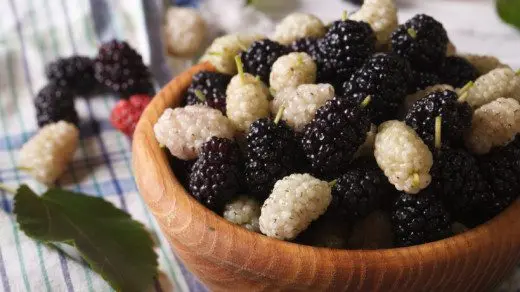😉 Greetings to regular and new readers! In the article “Mulberry: health benefits and harms, facts” – basic information about mulberry. What is its use, are there any contraindications. Interesting facts that you may not know about.
These juicy berries have been familiar to me since childhood. For some reason, all the local guys called the mulberry tree and its fruits mulberry. I’m talking about Taganrog, the southern Russian city where I was born and live. Different mulberries grow here: white, red and black.
White berries are almost tasteless, red – with sourness, black – sugar, aromatic and juicy. In summer, these berries are plentiful in city markets. Each berry resembles a miniature bunch of grapes, slightly resembling blackberries.

Mulberry is also called here, mulberry tree, tyutina. In the process of consuming black juicy berries, the tongue and fingers become dark from the juice. But they can be easily cleaned by the juice of unripe berries of the same tree. Nature has foreseen everything!
Why is a mulberry tree called mulberry? From the words “silk” and “silkworm”. Leaves are the main food source for silkworm larvae. The history of the silk tree begins in ancient China. The famous Chinese silk was obtained from the threads of the silkworm, which fed on tyutina leaves.
Tyutins make musical instruments and barrels for cognac and wine from valuable wood. Bark is a wonderful material for original amulets and amulets.
Due to the fact that the berries are very juicy and easily crumpled, they cannot be transported. So come to the place where it grows and enjoy! For the winter, many people dry, freeze or make delicious mulberry jam.
The history of the mulberry tree begins in ancient China. The famous Chinese silk was obtained from the threads of the silkworm, which fed on mulberry leaves. For 3500 years, China has been a silk monopoly. Chinese emperors ordered heads to be cut off for suspicion of revealing the secret of silk production.
Mulberry chemical composition
Composition, nutritional value
100 grams of the product contains:
- kcal – 43;
- water – 87,68 g;
- proteins – 1,44 g;
- fats – 0,39 g;
- carbohydrates – 9,8 g;
- sugar – 8,1 g;
- fiber – 1,7 g;
- valuable trace elements are present: potassium, calcium, selenium, iron, magnesium and sodium;
- many vitamins of group B. Ascorbic acid, vitamins A, K, D, PP.
Mulberry: beneficial properties
- vodka, wine, pie filling are made from juicy berries;
- tea made from mulberry leaves is useful;
- ripe fruits are a strong plant antioxidant;
- berries are useful for weight loss, obesity;
- choleretic and diuretic;
- with constipation, it has a mild laxative effect;
- anti-inflammatory effect;
- increases sweating;
- dilutes sputum;
- participates in the process of hematopoiesis;
- with anemia (iron);
- treatment of bronchitis, pneumonia;
- in diseases of the gastrointestinal tract;
- for the treatment of gout;
- stomatitis and periodontal disease;
- treatment of colds;
- It strengthens the immune system;
- reduces puffiness (diuretic);
- helps in times of depression;
- helps with insomnia.
Mulberry: contraindications
- sweet berries for diabetes can increase blood sugar levels;
- overeating can cause diarrhea;
- contraindicated for hypertensive patients;
- idiosyncrasy;
- when eating fresh berries, it is not recommended to drink cold water, this can provoke an upset stomach.
A small handful of mulberries will not harm hypertensive and diabetics. A little bit you can!
Read more in this video on “Mulberry: health benefits and harms”
Dear readers, share the information “Mulberry: benefits and harms to health” in the social. networks. 😉 Be sure to be healthy!









